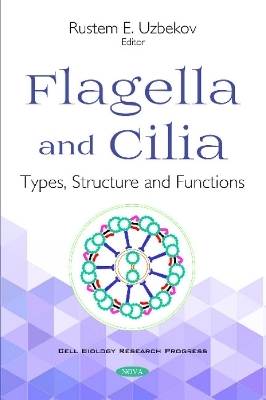
Flagella and Cilia
Types, Structure and Functions
Seiten
2018
Nova Science Publishers Inc (Verlag)
978-1-5361-4333-1 (ISBN)
Nova Science Publishers Inc (Verlag)
978-1-5361-4333-1 (ISBN)
Motility is an inherent property of living organisms, both unicellular and multicellular. One of the principal mechanisms of cell motility is the use of peculiar biological engines flagella and cilia. These types of movers already appear in prokaryotic cells. However, despite the similar function, bacteria flagellum and eukaryote flagella have fundamentally different structures. Chapter One of this book by Drs. Meijiao Wang, Li Zhang and Hanna Li is devoted to a comparative analysis of the flagella of prokaryotes and eukaryotes.Its believed that flagellum in eukaryotic cells appeared for the first time in ancient flagellates. In Chapter Two, Drs. P. Huitorel, M. Cachon and J. Cosson summarize the results of their long-term studies of flagellum dinoflagellates. The "evolutionary invention" of the ancient flagellates proved to be so successful that the axonemal structure in flagellum has not changed for hundreds of millions of years. In the third chapter, Drs. V. Bondarenko, G. Prokopchuk and J. Cosson reported the analyses of kinetic characteristics of flagella motions in fish using the most modern methodologies.In Chapter Four, Drs. R. Uzbekov, A. Garanina, J. Burlaud-Gaillard and C. Bressac described spermiogenesis of the parasitic wasps Cotesia congregata. Their data showed that significant shortening of the flagella occurs during the formation of the mature spermatozoon and this flagella has been the shortest spermatozoon flagella described in the animal kingdom until now. Centriole in this spermatozoon is transformed into a special structure known as the "cogwheel structure" that does not contain microtubules.In the process of multicellular organism evolution, flagella, which ensure the mobility of individual cells, gave origin to two types of cilia. Motile cilia in the tissues like cerebral ventricles, respiratory epithelium and oviducts moved liquid flows relatively to immobile cell layers. The second type of cilia (primary cilia) lost motility function and acquired cellular sensitivity function. Moving and sensitive cilia grow from basal bodies, which originate from centrioles. Chapter Five by Drs. I. Alieva, C. Staub, S. Uzbekova and R. Uzbekov discusses which of the centrioles mother or daughter creates the moving cilium and sensitive cilium.In Chapter Six, Drs. D. Conkar and E. Nur Firat-Karalar describe in detail the biochemical aspects of primary cilium assembly pathways, intraflagellar transport and ectosome release. This chapter provides an overview of the trafficking pathways involved in ciliary compartmentalization and describes the primary ciliary as a sensitive "cell's antenna", participating in many regulatory processes in the cell.Defects in flagella and cilia cause many hereditary diseases. Different examples of ciliopathy are described in Chapter Seven by Drs. E. Bragina, E. Blanchard and R. Uzbekov.A wide review of experimental models, organisms and analytical methods to study flagella and cilia are presented to readers who want to learn about their main research directives.
For more information, please visit our website at:Print: https://www.novapublishers.com/catalog/product_info.php?products_id=65520E-Book: https://www.novapublishers.com/catalog/product_info.php?products_id=65521
| Erscheinungsdatum | 26.10.2018 |
|---|---|
| Verlagsort | New York |
| Sprache | englisch |
| Maße | 155 x 230 mm |
| Gewicht | 300 g |
| Themenwelt | Naturwissenschaften ► Biologie ► Zellbiologie |
| ISBN-10 | 1-5361-4333-2 / 1536143332 |
| ISBN-13 | 978-1-5361-4333-1 / 9781536143331 |
| Zustand | Neuware |
| Haben Sie eine Frage zum Produkt? |
Mehr entdecken
aus dem Bereich
aus dem Bereich
mikroskopisch kleine Multitalente
Buch | Hardcover (2024)
Schweizerbart'sche, E. (Verlag)
29,90 €


